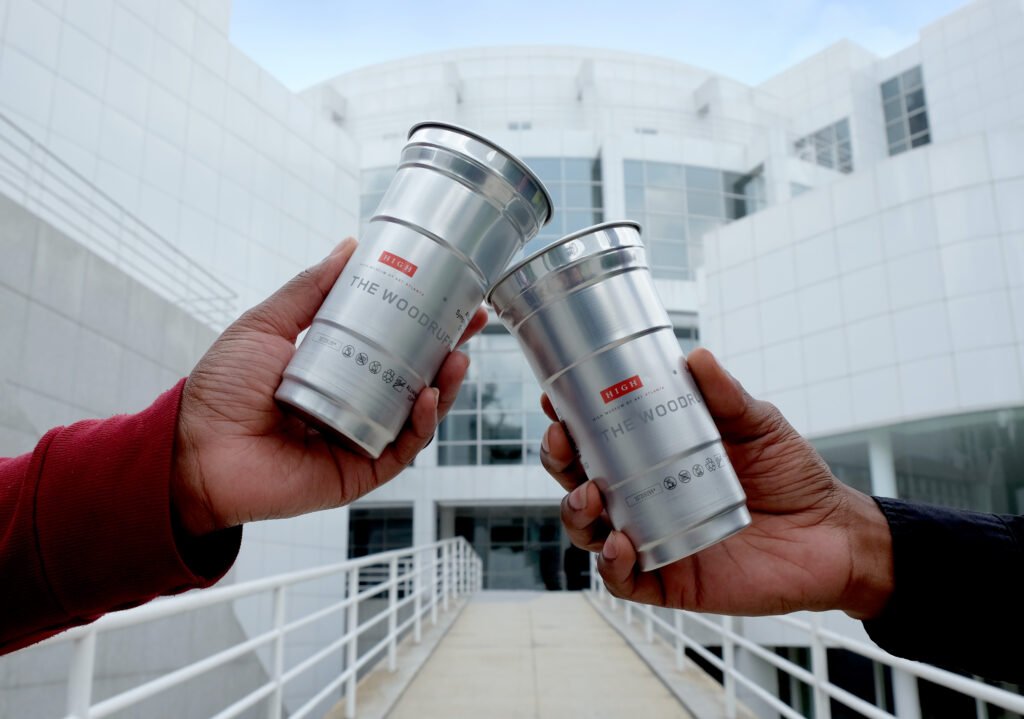Sustainability
The High Museum of Art is dedicated to the collection, interpretation, and preservation of art for present and future generations. But our mission is based on the assumption that there will be future generations to enjoy our art. That’s why we have a responsibility to care for our planet as much as we care for our collection.
This means reducing our carbon footprint through more sustainable practices—and raising awareness about the climate crisis with our visitors. Most importantly, it means collaboration. If you have questions about our sustainability programs or are interested in collaborating with us to make positive change, please contact us.
Eliminating Plastic
In 2023, the High Museum worked with the Atlanta Symphony Orchestra to eliminate the use of plastic cups at all Woodruff Arts Center events. Today the High Museum of Art, the Atlanta Symphony Orchestra, and the Alliance Theatre serve drinks in infinitely recyclable aluminum cups. Through this effort, the High expects to prevent more than one hundred thousand plastic cups from entering the landfill each year.

GoodUse Grant
In 2023, the High was awarded a GoodUse grant from Southface to increase the efficiency of our buildings, save on utility costs, and improve our environmental impact along the way.

EV Charging Stations
In 2023, The Woodruff Arts Center installed EnviroSpark Electric Vehicle Chargers for use by both visitors and employees.

Digital Membership Cards
In 2020, the museum enacted a digital membership card program. Since then, we have served eighty thousand members with digital cards, reducing plastic waste, paper waste (in the form of letters and envelopes), and fossil fuel consumption (in the form of transporting mail).

Recycling
We offer mixed-stream recycling outside on the Carroll Slater Sifly Piazza, in the Taylor Lobby, and throughout the administrative buildings to make it easier for visitors and employees to recycle without having to sort.

Printed Materials
The museum’s member magazine is printed on a portion of post-consumer recycled paper using sustainable UV dyes. We also launched a digital member magazine in 2020, and we allow members to opt out of all paper communications.

Green Roof
Installed in 2004 atop the Frances Bunzl Center, the museum’s 6,680-square-foot vegetated green roof helps clean and reduce stormwater runoff, reduce the urban-heat-island effect, reduce energy consumption, extend the roof life, and improve air quality. Our green roof is also able to retain about 62,000 gallons of stormwater.

LED
In 2012, the museum replaced all the gallery lighting in the Stent Family Wing with LED bulbs. Not only does this save energy, but it’s also better for our collection as LED produces less heat. We are currently working to secure funding to replace all the outdoor lighting on the Piazza and the gallery lighting in the Wieland Pavilion and the Anne Cox Chambers Wing.

Education
The museum has a responsibility to help people understand how they can contribute to a healthy planet and a sustainable future. We weave sustainability and conservation into our educational programming whenever possible. As a rule, our STEAM curriculum always includes content that focuses on the interdependent nature of our world and the impacts we make on each other and our planet.

Sustainable Growth
Sustainable development goes beyond reducing your carbon emissions. Because we understand that you can’t make sustainable choices if you lack information, resources, or access, we aim to reduce inequality where we can through a number of programs that increase access to the museum’s resources and support the health and well-being of our visitors, staff, and volunteers.
Diversity
For decades, the museum has made an effort to collect and present work by artists who represent our diverse community. We also strive to ensure our workforce is reflective of our audience. We began reporting on our progress in diversifying our collection and staff in 2020. Visit our Art + Inclusion report for more information.
Livable Wages
In FY 2021, the museum reappraised and addressed the notion of a livable wage for its employees. All museum employees now make either a minimum of $15/hour as nonexempt staff or $40,000/year as exempt staff.
Accessibility
- For Visitors: Through generous support from UPS and the Lettie Pate Evans Foundation, on the second Sunday of every month, the museum opens its doors to all visitors for free for UPS Second Sundays.
- For Students: The Art Access Program, generously supported by the Kendeda Fund and many individual donors, is designed to remove the economic barriers that typically prevent Title I school students from visiting the museum. Art Access provides Georgia schools with transportation reimbursement and free admission for students and chaperones.
- For Web Users: We are committed to making our website accessible to all users, including those dependent on assistive technologies. In 2023, we redesigned our site and worked closely with an accessibility expert to ensure it is usable by screen readers and people with impaired mobility. For more information on all of our accessibility programs, please visit high.org/access.
